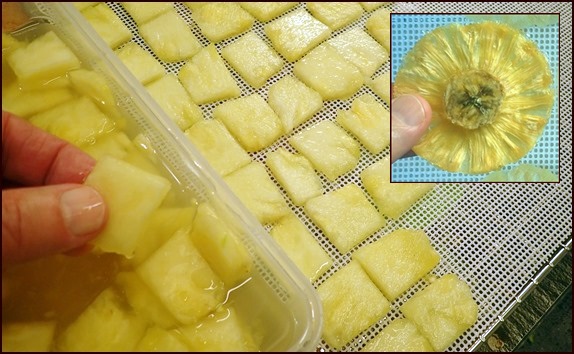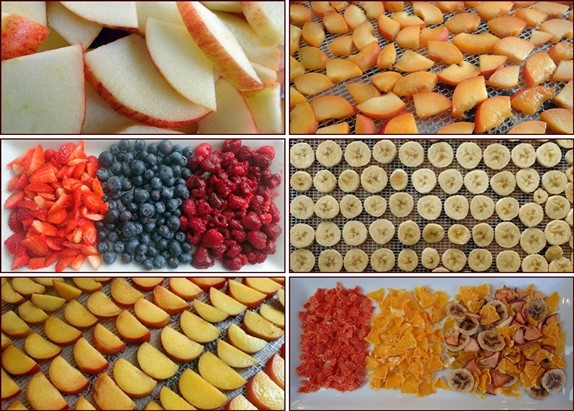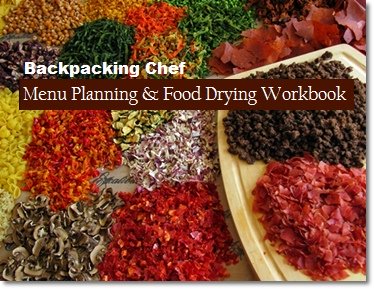Dehydrating Pineapple: Fresh, Canned & Delicious
The biggest benefits of dehydrating pineapple, for me, are tasting the sweet pineapple bits and juices while I’m prepping the pineapple for dehydration, followed by the reward of tasting those delicious flavors again in the dehydrated pineapple.
This article explores how to dehydrate fresh pineapple and canned pineapple, starting with tips for selecting a ripe pineapple. I’ll cover all the ways you can prepare pineapples for dehydration, including methods for dehydrating pineapples that are not-so-ripe.
Once the prep work is done, sit back and enjoy the delightful scent
of pineapple wafting into your home from the dehydrator. I also cover how to store dehydrated pineapple, and all the delicious ways to use it in trail mixes, fruit cocktails, smoothies, meals, and desserts.
The whole process brings joy and good health. Sharing dried pineapple rings with friends and family members evokes happiness and feelings of well-being. Pineapples have long symbolized hospitality, warmth, and good cheer.
Table of Contents
How to Dehydrate Fresh Pineapple
How to Dehydrate Canned Pineapple
Packing & Storing Dehydrated Pineapple
How to Select a Ripe Pineapple for Drying
The pineapples on display at your grocery store may have been picked before they were fully ripe, which means they won’t be very sweet or juicy, and they won’t get any sweeter after you take them home.
Pineapples are non-climacteric fruits; they do
not continue to ripen after being harvested. Source: UCDavis Extension.
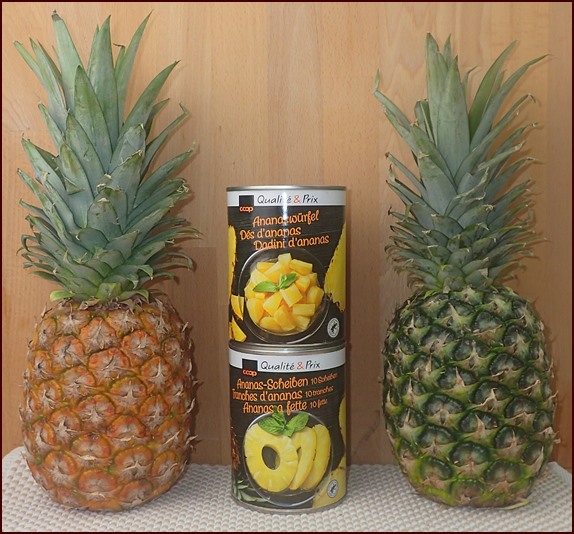
Photo: As you might guess, the pineapple on the left was sweeter than the pineapple on the right.
So how do you pick a ripe pineapple?
Appearance: Look for a pineapple that is light in color—golden yellow and light brown with some green. A pineapple that is mostly green is probably not fully ripe, while a pineapple that is on the darker brown side is likely overripe. The leaves should be rigid, not wilted.
Feel: Squeeze the pineapple gently; it should give just a little—firm, but not bowling-ball hard. If it gives easily to light pressure, it may be overripe or bruised from shipping, and the fruit inside may have brown spots.
Sniff Test: Smell the bottom of the pineapple. Is there a hint of sweet pineapple scent? Buy it! No scent at all may indicate low sugar content. Beware the scent of alcohol or yeast; the pineapple may have started to ferment from being too long in transit or storage.
Can you dehydrate an under-ripe pineapple?
Yes, but you’ll need to add some sweetness to the pineapple.
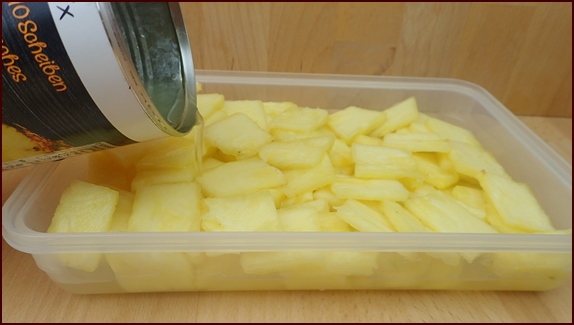
Two Ways to Dehydrate an Under-Ripe Pineapple:
Method 1: Soak in pineapple juice: Cut the pineapple into thin pieces, and cover them with pure pineapple juice from a can. Let them sit covered in a container for several hours or overnight in the refrigerator. Place pieces directly on dehydrator trays without rinsing.
Method 2: Make pineapple fruit leather with another fruit: Combine pineapple with an equal quantity of ripe banana or mango in a blender. Thin the mixture with one or two tablespoons of pineapple juice or orange juice. Blend until smooth.
Basic Recipe: To make one fruit leather, blend 125 – 150 grams of each fruit with a little extra juice.
Spread 1 – 1½ cups of the mixture on a nonstick sheet or silicone tray in the dehydrator. Dehydrate at 135°F (57°C) for eight to ten hours.
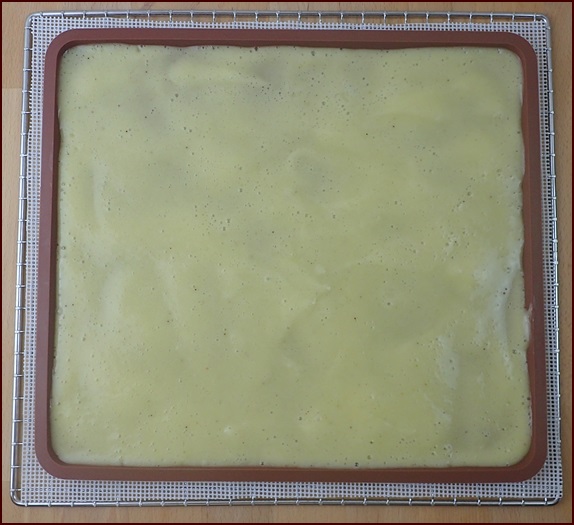
Photo: One cup of blended pineapple and banana on silicone dehydrator tray.
What is the best way to dehydrate fresh pineapple?
Method 1: Cut pineapple into thin slices. That’s the fastest way to dehydrate it, and the dried pineapple pieces are the perfect size to use in trail mixes, fruit cocktails, and dehydrated meals like Hawaiian Shrimp & Rice.
Method 2: Slice pineapple into rings. Because rings are thicker, they may take up to five hours longer to dehydrate than thin slices. They retain a little more moisture than dried pineapple slices, which makes them irresistibly delicious to munch on.
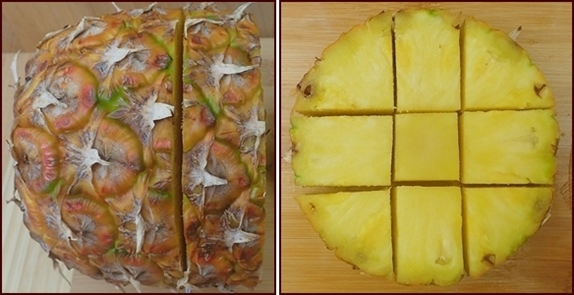
Thin Slices
1. Cut the pineapple crosswise into ¾-inch to 1-inch thick rings.
2. Trim the fibrous skin off of each ring.
3. Slice the rings crosswise into thinner ⅛-inch thick pieces.
Discard the hard core from the center as you cut.
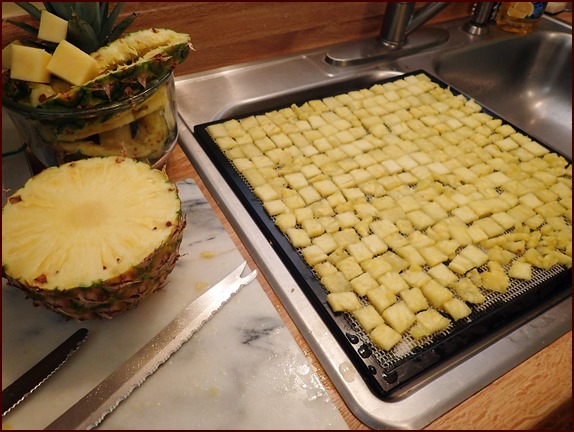
Photo: Fresh pineapple cut thinly into pieces ¾-inch to 1-inch square, single layer on Excalibur dehydrator tray.
4. Place pieces on a nonstick dehydrator sheet in a single layer.
5. Dehydrate thin-sliced pineapple at 135°F (57°C) until pliable, approximately 10–12 hours.
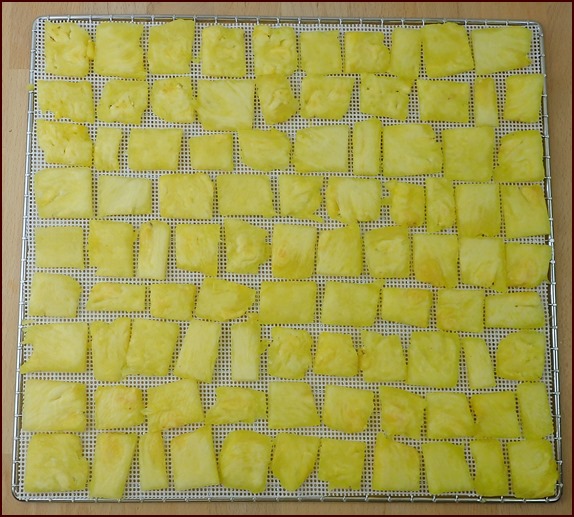
Photo: Pineapple pieces before dehydrating in a Cosori dehydrator using a silicone mesh sheet.
In the photo below, the slightly under-ripe pineapple pieces on the left dried to a lighter color. The perfectly ripe pineapple pieces on the right took on a little brown color, which is normal due to the higher sugar content.
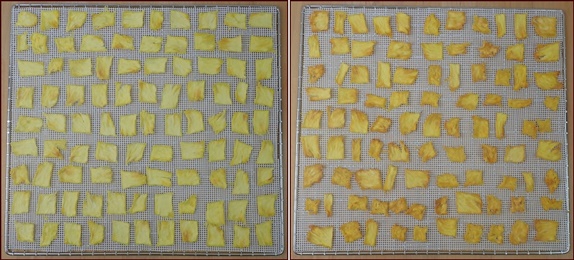
As expected, the dehydrated pineapple on the right was sweeter, but since I had soaked the pineapple pieces on the left in pineapple juice, both were delicious.
The pineapple pieces from the sweeter pineapple also took on some light-brown color due to the higher sugar content.
Dehydrating Pineapple Rings
Place rings in dehydrator using a nonstick mesh sheet. The mesh sheets that come with Excalibur dehydrators are fine for drying fruits. With Cosori dehydrators, silicone mesh sheets (purchased separately) work much better than the plastic mesh sheets that come with the dehydrator.
Dehydrate pineapple rings at 135°F (57°C) until pliable, approximately 15–18 hours. Dried pineapple rings should retain enough moisture so that they are pleasantly chewy — not hard and crispy.
The quick and easy way to dehydrate pineapple rings is to use canned pineapple rings, but with a little more prep work, fresh pineapple rings are wonderful, too.
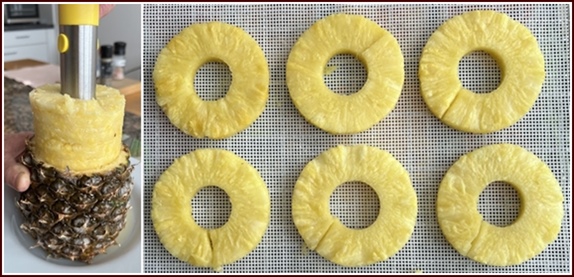
Fresh cut pineapple rings have a more vivid yellow color than canned pineapple rings, which tend to be paler.
I’m not usually a gadget guy, but when it comes to slicing fresh pineapple rings, a pineapple corer & slicer is the way to go. Any fruit left behind can be used to make pineapple fruit leather.
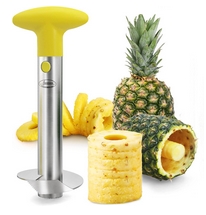
Rings will have uniform thickness, which ensures they will all dry evenly in the same amount of time.
The Newness Pineapple Corer & Slicer shown in the photo sells for under $15 on Amazon. (Affiliate link)

With a pineapple corer & slicer, you can quickly cut pineapple rings into chunks.
Read my review here:
Coring Pineapples with a Newness Pineapple Corer & Slicer
Cutting Pineapple Rings with a Knife Only
To cut a fresh pineapple into rings with just a knife, trim off the skin of the pineapple, then cut the pineapple crosswise into ½-inch thick rings. Trim away core from each ring with a serrated paring knife.
How many pineapple rings can you fit on one dehydrator tray?
It’s a little tight, but sixteen rings will fit on a Cosori dehydrator tray. Pineapple rings shrink as they dry, opening up space between the rings.
With an Excalibur dehydrator, you can also dry sixteen intact rings, but you can dry more pineapple by cutting some rings in half to take advantage of the larger tray size.
Here’s a fun trick:
Place a banana slice in the center hole of each pineapple. As the pineapple rings shrink, they hold the banana slices in place. They look a little like flowers, and your friends will love them.
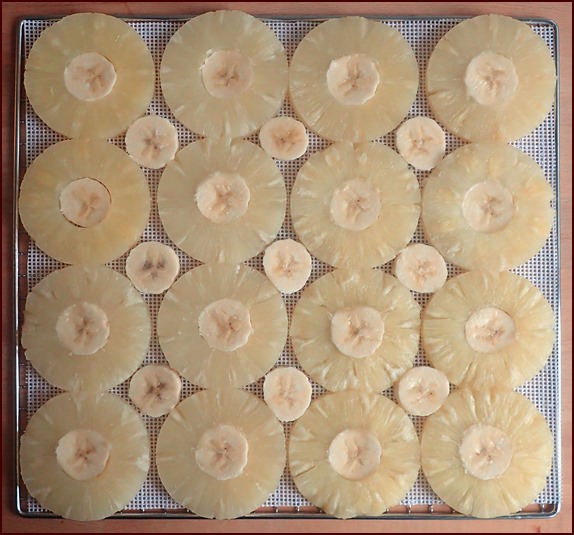
Photo: Filling the extra space between pineapple rings on a Cosori dehydrator tray with banana slices. Rings are from a can.
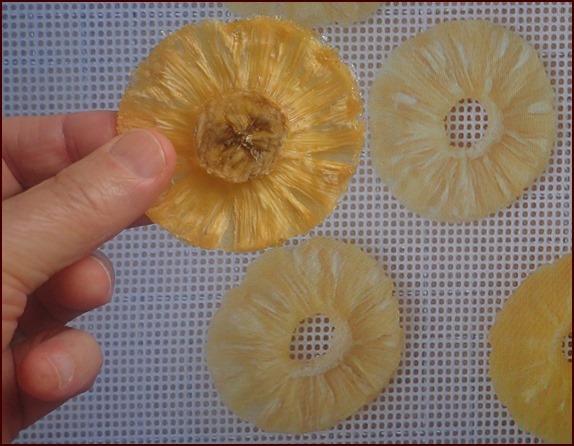
How to Dehydrate Canned Pineapple
Dehydrating canned pineapple is super easy. Because the canned pineapple is saturated with sweet pineapple juice, the dried pineapple is very sweet.
Place the rings or wedges directly on nonstick mesh sheets in a single layer and dehydrate at 135°F (57°C) until pliable, approximately 13–18 hours, with the smaller wedges drying faster than rings.
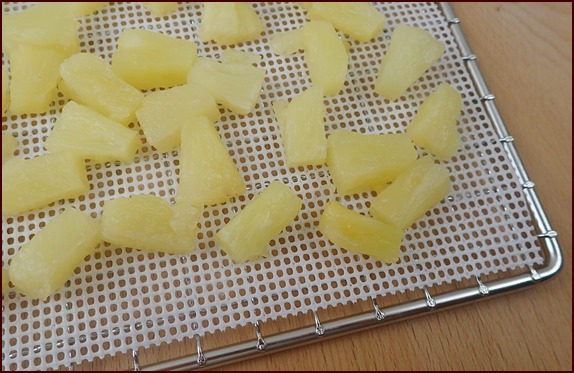
Photos above and below: Dehydrating canned pineapple wedges, before and after drying.
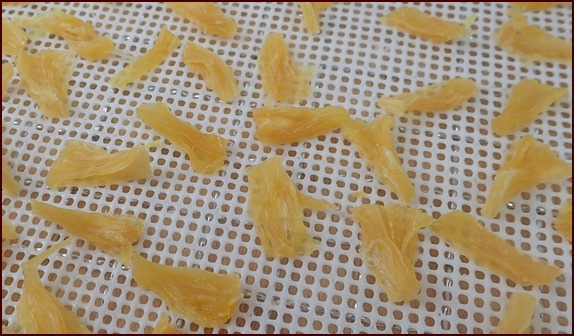
Dehydrated pineapple wedges or chunks are chewier than thinner dried pineapple slices.
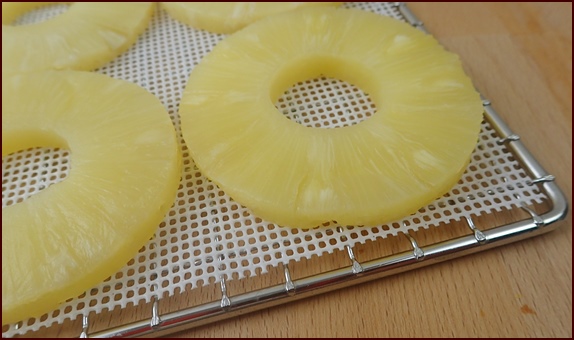
Photos above and below: Dehydrating canned pineapple rings, before and after drying.
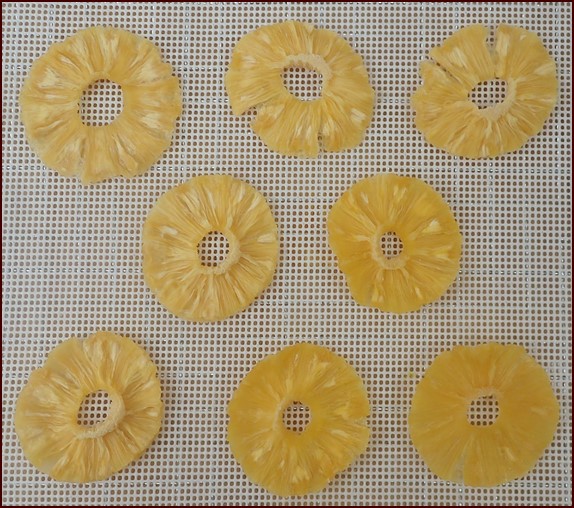
Packing & Storing Dehydrated Pineapple
Dehydrated pineapple keeps well in storage. The main thing is to seal it off from moisture. After several months in storage, it may take on a little brown color due to oxidation, but this can be minimized by vacuum sealing or using oxygen absorbers. Keep in mind that some browning may occur while the pineapple is dehydrating, particularly with very ripe pineapples.
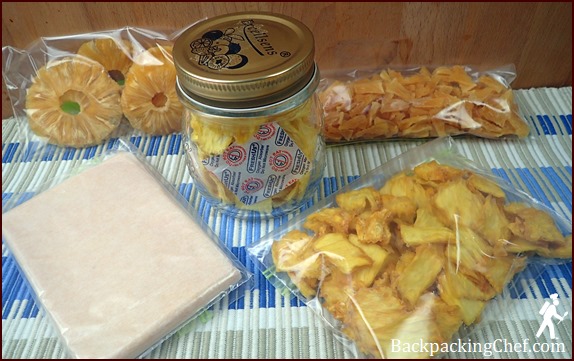
Photo: Dehydrated pineapple rings, wedges, slices, and leather—packed and soon to be enjoyed by Chef Glenn & Dominique.
Short-Term Storage: Pack dehydrated pineapple in ziptop bags to prevent moisture reabsorption. Store in a cool, dark place. Dried pineapple in ziptop bags will easily last a month at home or on the trail.
Mid-Term Storage: For home storage between one month and six months, store dehydrated pineapple in glass jars with tight-fitting lids. Seal the jars with a vacuum sealing accessory or enclose an oxygen absorber in the jars. Use the smallest jars possible to accommodate the fruit.
See: Backpacking Chef Gear Guide: Storage Accessories.
Alternatively, place ziptop bags of dried pineapple in a plastic container with a tight-fitting lid, and store in the refrigerator.
Long-Term Storage: For extended backpacking trips or home storage from six months up to a year or more, use one of the three storage methods below to completely lock out air and moisture.
Method 1: Vacuum-sealed bag with oxygen absorber.
Method 2: Sealed Mylar bag with oxygen absorber.
Method 3: Glass jar with oxygen absorber. Vacuum-seal jars with jar sealing accessory.
What can you do with dried pineapple?
Dehydrated pineapple is sweet and delicious all by itself, but it also loves company. I use it in trail mix, fruit cocktail, spoon smoothies, granola bars, dehydrated meals, and backpacking desserts.
Tropical Fruit Trail Mix
Combine dried pineapple with dried mango, bananas, and coconut. Leave it at that, or add sliced almonds or cashews, granola, etc.
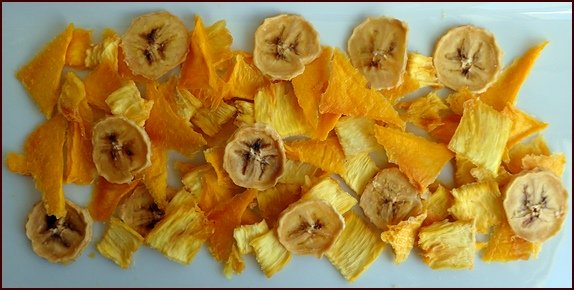
Photo: Dehydrated pineapple, mango, and banana.
Tropical Fruit Cocktail
Tropical fruit cocktail is super-refreshing on a hot day, and it’s full of nutrition and energy to keep you going
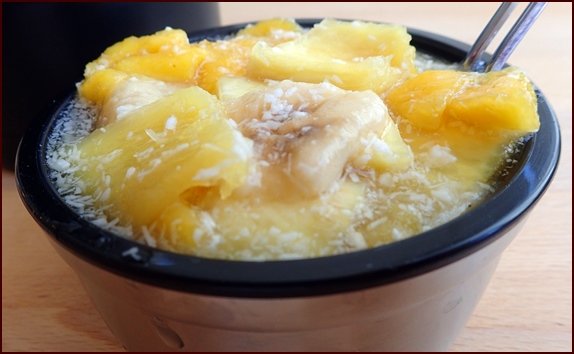
Photo: Dehydrated pineapple, mango, and banana—rehydrated into a tropical fruit cocktail with coconut.
Ingredients:
Servings: 1 large
- ⅓ cup dried mango (15 g)
- ⅓ cup dried pineapple (15 g)
- ¼ cup dried banana (10 g)
- 1 Tbsp. dried coconut (5 g)
Rehydrate with one cup cold water.
On the Trail:
Combine all ingredients with cold water in a container with a tight fitting lid. A thermos food jar works great and keeps the fruit cocktail cold. Wait at least one hour for best rehydration, but a longer soak is fine. The juice remaining with be sweet and refreshing.
Ginger-Mango Spoon
Smoothie with Pineapple
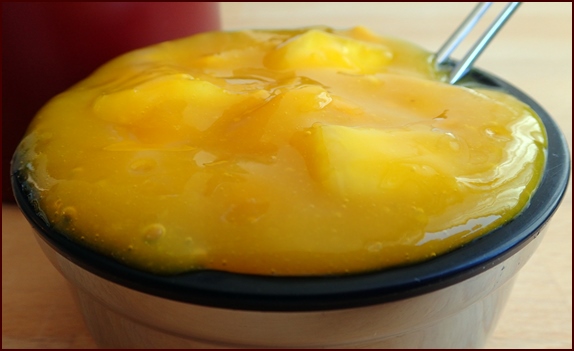
Ingredients:
- 1 sheet of ginger-mango fruit leather (50-60 g)
- ½ cup dried pineapple (25 g)
- 1¾ cup cold water to rehydrate
More recipes: Mango-Pineapple Fruit Leather.
Pineapple Granola Bars & Clusters
These are absolutely delicious. Granola bars and clusters with nothing but nutritious fruit as the binder. Easily formed into snack-size bars and dehydrated.
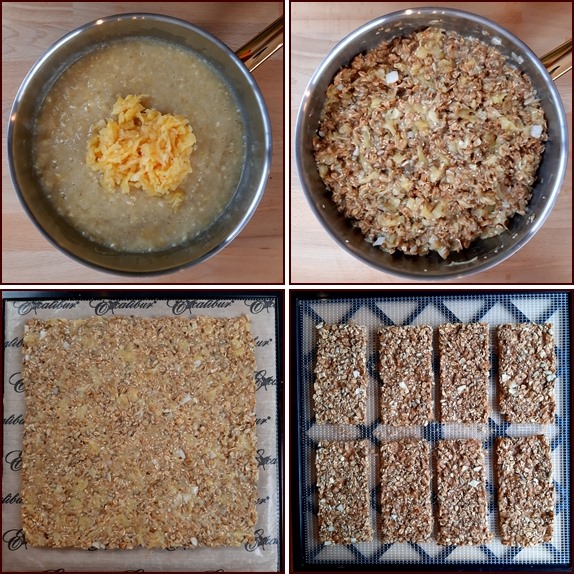
Recipes:
Hawaiian Shrimp & Rice

Dehydrated pineapple adds a sweet and tropical flavor to this meal with shrimp and rice.
Recipe: Hawaiian Shrimp & Rice
Pineapple Upside Down Cake.
Who can resist warm vanilla pudding, cake, coconut, and pineapple after a long day of hiking?
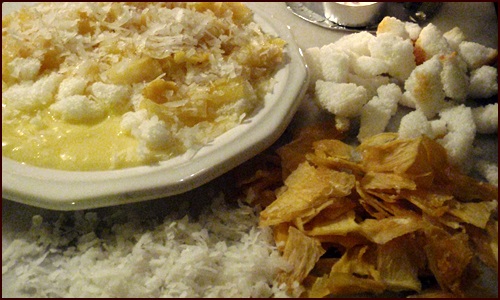
Photo: Dehydrated pineapple rehydrated in Pineapple Upside Down Cake.
Recipe: Pineapple Upside Down Cake.
FAQ About Dehydrating Pineapple

Ask Chef Glenn
If you have a question after reading this page, send it to me, and I’ll get back to you soon.
How can you tell when dried pineapple is done?
How can you tell when dried pineapple is done?
Dried pineapple slices will bend in half, but not break. They will not feel moist on the inside, nor will they feel sticky on the outside. Dried pineapple rings will also bend or flex. They may retain a little more moisture than dried slices, and they may be slightly stickier than thin sliced pineapple pieces.
Can you over-dry pineapple?
Can you over-dry pineapple?
Yes. If you dehydrate pineapple to where it has less than 10% moisture content, it will be harder to chew and slower to release its sweet flavor. The outer edge of pineapple rings may feel woody if you over-dry them.
Do you need to condition dried pineapple?
Do you need to condition dried pineapple?
If you plan to store dried pineapple for more than a month, then conditioning is a good idea to make sure the pineapple is sufficiently dry. Place dried pineapple in a glass jar with lid. Check the jar for one to three days for any moisture appearing on the inside of the jar. If you see any moisture, return the pineapple to the dehydrator and continue drying.
Can you dehydrate frozen pineapple?
Can you dehydrate frozen pineapple?
Yes. If the frozen pineapple is in chunky pieces, cut the chunks into thinner slices when the pineapple is partially thawed. Taste. If not very sweet, presoak in pure pineapple juice for several hours before dehydrating. Pineapple that is “freezer burned” will not taste good when dried. Use the whole, unopened package for best results.
Accessories for Dehydrating Pineapple
Shop Amazon
Shop Amazon for the accessories used for dehydrating pineapple on this page.
Silicone trays with raised edges are very useful for dehydrating pineapple fruit leather. If you have a dehydrator with stainless steel trays, such as a Cosori dehydrator, then you’ll want to order silicone mesh sheets to dehydrate pineapple. They are truly nonstick and easy to clean. The mesh sheets that come with Excalibur dehydrators work fine.

Left: Cosori Dehydrator, Stainless Steel, 6-Trays
Middle: Silicone Dehydrator Trays with Raised Edges, 11.8" x 10.8", 6-Pack
Right: Silicone Mesh Dehydrator Sheets, 14” x 14”, 12-Pack
Also: Newness Pineapple Corer & Slicer
Disclosure: As an Amazon Associate, Backpacking Chef earns from qualifying purchases.
Share this page with friends on social media.
Free E-book & Newsletter
Free with Trail Bytes subscription.
Dehydrating Food from A–Z

